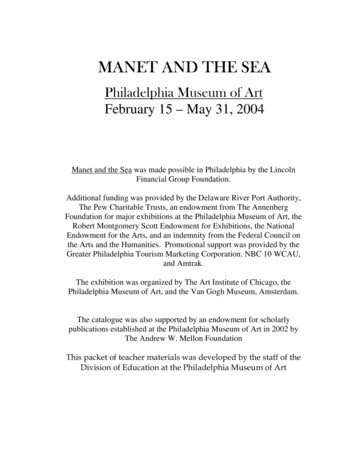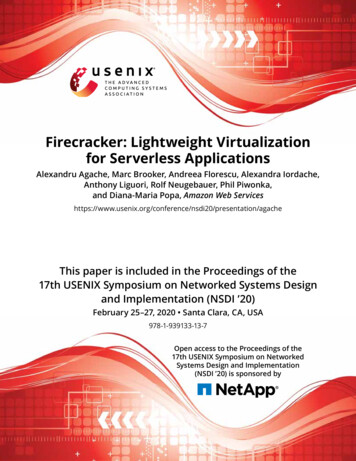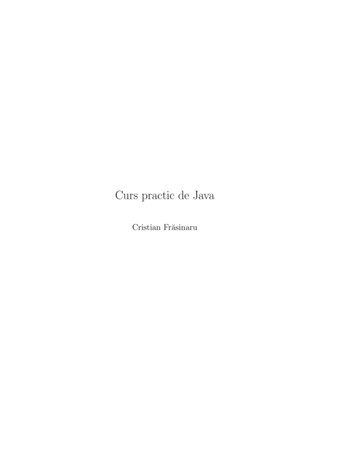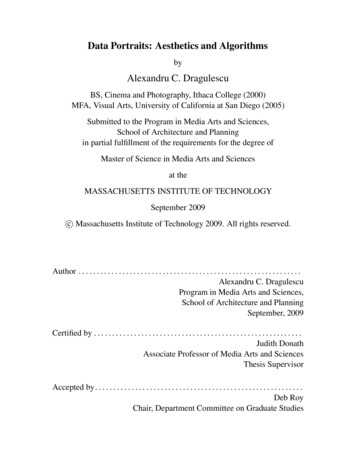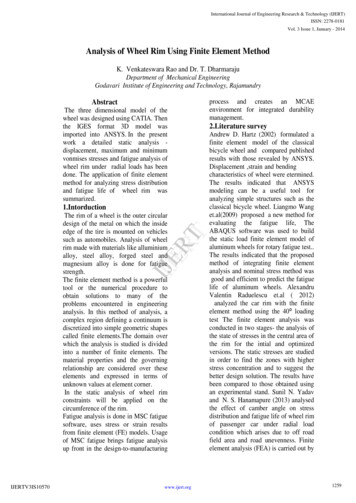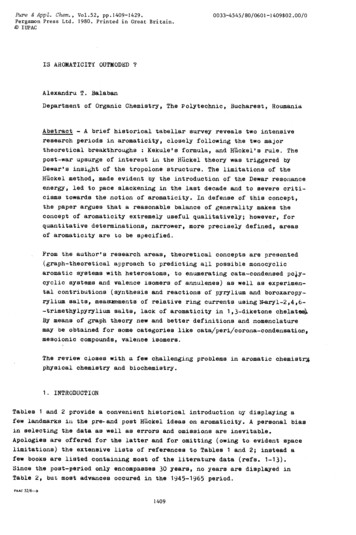
Transcription
Pure & Appi. Chem., Vol.52, pp.1409—1429.Pergamon Press Ltd. 1980. Printed in Great Britain.IUPACIs0033—4545/80/0601—1409 02.OO/OAROMATICITY OUTMODED ?Alexandru T. BalabanDepartment of Organic Chemistry, The Polytechnic, Bucharest, RoumaniaAbstract A brief historical tabellar survey reveals two intensiveresearch periods in aromaticity, closely following the two majortheoretical breakthroughs Kekule's formula, and Hückei's rule. Thepost-war upsurge of interest in the Hackel theory was triggered byDewar's insight of the tropolone structure. The limitations of theHUckel method, made evident by the introduction of the Dewar resonanceenergy, led to pace slackening in the last decade and to severe criticisms towards the notion of aromaticity. In defense of this concept,the paper argues that a reasonable balance of generality makes theconcept of aromaticity extremely useful qualitatively; however, forquantitative determinations, narrower, more precisely defined, areasof aromaticity are to be secified.From the author's research areas, theoretical concepts are presented(graph—theoretical approach to predicting all possible monocyclicaromatic systems with heteroatoms, to enumerating cata-.condensed poycyclic systems and valence isomers of annulenes) as well as experimen-.tal contributions (synthesis and reactions of pyrylium and boroxaropy—rylium salts, measments of relative ring currents using N-aryl-2,4,6-.trimethylpyryliumsalts, lack of aromaticity in 1,3-diketone chelatea),By means of graph theory new and better definitions and nomenclaturemay be obtained for some categories like cata/peri/corona-condensatior,,mesoionic compounds, valence isomers.The review closes with a few challenging problems in aromatic chemistrphysical chemistry and biochemistry.1. INTRODUCTIONTables 1 and 2 provide a convenient historical introduction oy displaying afew landmarks in the pre-arid post HUckel ideas on aromaticity. A personal bia8in selecting the data as well as errors and omissions are inevitable.Apologies are offered for the latter and for omitting (owing to evident spacelimitations) the extensive lists of references to Tables 1 and 2; instead afew books are listed containing most of the literature data (refs. 1—13).Since the postperiod only encompasses 30 years, no years are displayed inTable 2, but most advances occured in the 145—1965 period.PAAC 52/6—s1409
1410ALEXANDRU T. BALABANTable1Pre-Htickel facts and ideas on aromaticityYearAuthor(s)R e s u 1 t s16081776B. de BignireObtains benzoic acidC. W. ScheeleDiscovers uric acid., rediscovers benzoic acid1825M. FaradayJ.Liebig, F.WöhlerJ. W. DöbereinerE. A. MitscherlichA. W. Hofmann,C. B. MansfieldAndersonP. GriessF. A. KekuleDiscovers benzene in whale oil gas condensateB. ErlenmeyerJ. DewarC. GraebeDefines aromaticity by reactivityProposes Dewar berizene formulaW.Körner, J.DewarPropose pyridine. formulaObjects Kekule formula, advocates 6918691872A.F.1881—5 E.1882-8 A.l83LadenburgA. KekuleFischerClaus, H. E.Arm-strong, A.BaeyerV. MeyerG. MerlingI. L. KondakovRecognize benzoyl radicalbenzaldehydeObtains furfural from vegetal productsDecarboxylates benzoic acid to C6H6; analysisDiscover benzene in coal tarDiscovers pyridineDiscovers diazonium saltsProposes benzene formula and term "aromatic"naphthaleneProves Erlenmeyer's naphthalene formulaOscillating bond hypothesisSynthesises purine. bases (Nobel Prize 1902)Centric benzene formulaE. BarnbergerDiscovers thiophene in coal tar benzeneObtains tropyliurn but fails to recognize itFails to look for water-soluble pyrylium salteCentric formulas for 5-mexnbered heterocyclesV. MeyerJ. ThieleDiscovers diaryliodonium saltsPartial valence hypothesis18991901J.W. Collie, T.TickleObtain crystalline pyrone methiodidesObserves acidity of C5H6 and lack of it for C7H81905A. BaeyerR. Wi1lsttterNobel PrizePrepares alkylsubstituted pyrylium saltsNobel Prize ; anthocyanine structuresAdvocates aromatic sextet of electrons1926A.R.R.A.1928O.Diels, K.Alder1925—9A. Lapworth,C. K. Ingold19301931—81931—919381943H. 925J.ThieleBaeyerWillstätterRobinsonStockObtains C8H8 and disproves Thiele's hypothesisE. HtickelPrepares borazineDiscover the diene reaction (Nobel Prize, 1950)Mechanism of aromatic electrophilic substitutionsNobel Prize for hemin and chlorophyll structuresHMO Theory, HUckel Rule for aromaticityR. RobinsonN. G. EvansA. C. ByrnsAnthocyanine syntheses (Nobel Prize, 1947)Proposes aromatic transition state in diene react.Fails to recognize pyryliuxn chlorozincates
Table 2. Post-HUckel facts and ideas on aromaticityR e 5 U 1 t SAuthor(s)J. i. AiharaA. J. AsheA. T. BalabanE.V.R.N.E.D. BergmannBoekelheideBreslowCalvinClarC. A. CoulsonD. P. CraigD. J. CramF.H.C.Crick,J. D.WatsonR. CriegeeR.Daudel,B. PullmannH. J. Dauben Jr.M. J. S. DewarW. E. DoeringK. DimrothJ. A. Elvidge,L. N. JackmanE. 0. Fischer,1411Applies GT fOr calculating DREAs-, Sb-, Bi-heteroatoms in six-membered heterocyálesTheor. :GT for heterocycles, polycyclics,valence—isomersExp.: Pyryliuxn, pyridiniurn and boroxaropyrylium saltsFulvenes(14] Annulenes with substituents in freictron cavityCyclopropenium saltsRenews Robinson's hypothesis on arom. of metal chelatesCondensed benzenoid hydrocarbons ; local sextetsNO Theories for aromaticitySymmetry of ground state wave, function as CFACyclophanes, bent and battered berizene rings"Nobel Prize for double helix structure of DNA, basedon pairing of complementary aromatic basesTetramethylcyclobutadiene and its dimersNO Theories for carcinogenicity of polycyclic aromatichydrocarbonsDiamagnetic susceptibility exaltation as CFATheor.: Tropolone structure 7 DRE using new standardExp.: Boroxaro— and borazaro-analogues of benzenoidsTropylium salts ; predicts bullvalenePyrylium salts 7 phosphorinsRing currents as CFANobel Prize for metallocenesG .WilkinsonN. J. Goldstein,R. HoffmannI. Gutman GTK. HafnerE. Heilbronner,G. BinschSpiroconjugationGT and topologocal properties of aromaticsAzulene and pentalene derivativesFirst and second-order bond fixation as CFAB.A.Hess, L.J. Schaad Obtain DRE on the basis of simple HMO and GT methodsR.A.C.A.HuisgenJulgJutzR. KatritzkyT. J. KatzJ. Kruszewski,T .New mesoionic compounds (mUnchnones), pentazolesBond distance equalization as CFABorabenzene anionProtonation of pyridones does not interfere with arom.Dianions of cycloöctatetraene and other annulenesHarmonic oscillator index as CFAN. KrygowskiJ. F. LabarreFaraday effects in aromatics ; strobilism as CFAMeneidic character as CFAD. LloydH.C.Longuet-Higgins Alternating bond lengths calculated for large annulenesL. SalemAbbreviations : CFA criterionenergy 7 GT graph theory .for aromaticity ; DRE Dewar resonanceTable continues on next page
ALEXANDRU T. BALABAN1412G. MaierG. MärklR. H. MartinJ. F. W. McOmieV. I. MinkinJ. I. MusherH. MussoC.D.Nenitzescu,M. AvramT. NozoeG. A. Olahw. D. OllisP. L. PausonR. PettitJ. R. Platt0. E. PolanskyM. RandiTable 2 (continued)Tetrahedrane derivatives ; silabenzenePhosphorinsLarge helicenes, their non-planarity and chiralityDiphenylenesFluctuating and static Meisenheimer complexesCriticizes ring current as CFAMeasures ring currents, metal chelates are not aromaticCyclobutadiene dimers ; first valence isomer of anannulene, the Nenitzescu hydrocarbon (CH)loTropolonesDications of (CH)4(CH)8 and other systemsMesoionic compounds : sydnonesFerroceneHomotropylium ; cyclobutadieneApplies HUckel's Rule to periphery of polycyclicsMO Methods for local sextetsGT Methods for local sextetsBullvalene ; large annulene ionsLarge annulenes or dehydroannulenes and their ionsG. SchröderF. Sondheimer,P. J. GarrattUranocene ; MO methods for aromaticsA. StreitwieserE. E. van TamelenPrepares Dewar—benzene and V.10 1 annuleneTopological resonance energies ; GT methods for arom.N. Trinajsti6PentazolesI. UgiE. VogelBridged V.10] annulene and larger ones, ions, ketonesEquivalence of all seven tropylium atomsM. E. VolpinMO Studies of aromatic substitution intermediatesG. W. WhelandAlgebraic structure count of Kekule structures usingC.F.Wilcox,GT methodsW.C.HerndonK.E.Wilzbach L.Kaplan : Benzvalene, photochemistry of benzeneS. WinsteinHomoaromaticityR.B.Woodward R.Hoffmann : Their rules for aromatic transition statesMeasurements of ring currentsH. WynbergR. ZahradnikMO Calculations for non—alternant systemsIt may be seen clearly that during the past 150 years the "temporal density"of discoveries and research in the field of aromaticity was far from uniform.The two outbursts which may be noted followed closely the two theoreticalbreakthroughs, namely the Kekulé formula and the Hackel theory. Tables 1 and 2will be discussed in more detail in the next section. Table 2 also displaysthe topics from the present author's research areas which will be discussed ina later section.2. HISTORICAL BACKGROUND'After Faraday's di3covery of benzene in 1b25 in the condensate of an illuini.nating gas obtained from pyrolysia of whale oil, Mitseherlich obtained thesame hydrocarbon by decarboxylating benzoic acid which had been known earlier,and established the benzene molecular formula as 06H6 in 1834. In 1845A. W. Hofmann and C. B. Mansfield discovered benzene in coal tar, and proposed methods for isolating benzene from this source, though thiophene which accom—panied benzene from coal tar was recognized by Victor Meyer only in 1863.Immediately after 1865 when Keku1 proposed his famous formula for benzene,the first cyclic formula of a chemical substance, there followed a period ofintensive research and development, both in advancing the limits of knowledgeand in applying this knowledge for practical uses, mainly in the dyestuffindustry.
Is aromaticity outmoded?1413Kekid also introduced the worde "aromatic" and "aromaticity" to describestructural characteristics of compounds related to benzene, i.e. the presenceof cyclic conjugation in 6-membered rings. His treatise of organic chemistryis based on the dichotomy aromatic — aliphatic.The objections raised by Ladenburg that one, not two, ortho-disubstitutedisomers may be always isolated, were countered in 1872 by Kekui& through hisoscillating bond hypothesis.Erlenmayer was the first proponent of a generalizingftend which was bound tocontinue afterwards, namely by proposing that the concept of aromaticityshould be associated to similar reactivity rather than similar structure.This generalization which encompassed Erlenmayer's naphthalene and VictorMeyer's thiophene, enabled Bamberger in 1891-3 to recognize the importance ofthe six free valenciea by adapting to five-.membered heterocycles the Armstrong-Baeyer centric formula, to which Claus, the proponent of an impossiblediagonal formuia,had also adhered.A blind, yet fruitful, alley was Thiele's explanation (1899) of the apparentsaturation of benzene through the "residual valency" hypothesis. In 1911Wiilstätter, prompted by Thiele's ideas, prepared cyclooctatetraene anddisproved thereby Thiele's hypothesis that all conjugated cyclopolyenes werearomatic; however, traces of Thiele's theory still linger in recent textbooksattributing mainly to steric strain the non—planarity of cyciooctatetraeneand the instability of cyclobutadiene, instead of the principal factor, theiranti—HUckel character (4n it—electrons).A clear filiation of ideas is traceable from (i) Armstrong-Baeyer's centricformula of benzene (1887), through (ii) Bamberger's recognition (1891—1893)that even five—membered heterocycles like thiophene or pyrrole could bewritten to display a hexacentric system through what we nowadays called anunshared electron pair, to (iii) Armit and Robinson's aromatic sextet of elecHUckel's merit to propose the first, crude,trons (1925). However, it was Eri3quantum—mechanical model for aromatic compounds and to obtain thereby themagic 4n 2 n—electron rule. Although its importance was not recognized immediately, HUckel's theoretical insight had opened the gates of discovery andapplications in the dyestuff and pharmaceutical industry.I consider that M. J. S. Dewar was instrumental in triggering the post-warrevival of interest in aromaticity and in the HUckel theory both through histheoretical insight (elucidation of the tropolone structure in 1945 (ref. 14),restatment of HUckel's prediction that tropylium should be aromatic as wasindeed proved later by Doering, and, last but not least, the formulation of abetter standard than HUckel's for the conjugation energy in aromatics leadingto the Dewar resonance energy (ref. 15)) as well as through experimentalevidence for borazaro and boroxaroaromatics.It is interesting that though earlier discoveries in organic chemistry wereoften serendipitous, the present-day state of art is such that unless one
ALEXANDRU T . BALABANI 41 4knows what to look for, interesting products escape detection; suen are thecaees (mentioned in Table 1) of (i) tropylium bromide obtained earlier byMerling, and (ii) of pyrylium salts formed by Friedel Crafts diacylation ofalkenes; the former product, when it was first obtained accidentally, hadsuch unexpected properties (water solubility) that its atricture could not beguessed; the latter salts escaped notiøe for a long time also because of thewater solubility of the chioroaluminates; when zinc chloride was the Friedel!Crafts catalyst and crystalline pyrylium chiorozincates had been obtained,complexes of 1,3—diketones. A third ease notthese were mistaken for ZnCl2mentioned in Table 1 is of pentazoles which had first been produced in 1093 byNoelting and Miohel without being recognized; only the kinetic analysis of N2evolution inducedHuisgen and Ugi to look for, and discover, pentazoles(ref. 16).Ralowing the upsurge of interest for novel types of aromaticity, exciting discoveries were made by Vogel for bridged 10—, 14-. and 18—3t—electron systems, byBoekelheide for 14.-it-electron systemS, by Sondheimer on large annuienes anddeh.ydroannule
Oscillating bond hypothesis Synthesises purine. bases (Nobel Prize 1902) Centric benzene formula Discovers thiophene in coal tar benzene Obtains tropyliurn but fails to recognize it Fails to look for water-soluble pyrylium salte Centric formulas for 5-mexnbered heterocycles Discovers diaryliodonium salts Partial valence hypothesis Obtain crystalline pyrone methiodides Observes acidity of C5H6 .




